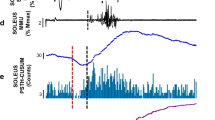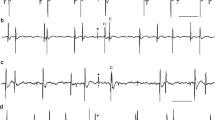Abstract
There are several parameters associated with motoneuron size, among which are the conduction velocity of the axon as well as the size of the excitatory postsynaptic potential (EPSP) induced by stimulation of Ia afferents in the corresponding muscle nerve. In particular, it has been established in animal experiments that small motoneurons with a low conduction velocity exhibit large Ia EPSPs, whereas large motoneurons with a high conduction velocity show small Ia EPSPs. Thus small motoneurons are recruited earlier than large ones. In this study, we investigated whether such a relationship between motoaxon conduction velocity and size of the Ia EPSPs could also be found for human soleus motoneurons. In total, 36 motor units from six healthy volunteers were activated by a slight voluntary contraction and exposed to 200 stimuli of the tibial nerve in the popliteal fossa. Stimuli were delivered using a special stimulus protocol ensuring a constant pre-stimulus spike density along with a constant rate of discharge of the investigated unit. From the stimulus-correlated spike train data a measure of Ia-EPSP amplitude was obtained, along with the single-unit H-reflex latency. Additionally, for each unit, the so-called surface macro EMG was recorded, which measures the complete electrical activity attributable to the unit investigated. From the macro EMG, the intramuscular delay from arrival of each action potential at the soleus muscle and the detection of the muscle-fiber action potential picked up by the recording needle electrode were measured. All single-unit H-reflex latencies were corrected for the corresponding intramuscular delays. From the corrected latencies, single-unit conduction velocities were obtained. It was found that there was a highly significant negative correlation between the estimate of the single-unit conduction velocity and the inferred size of the Ia EPSP. Thus, it was found that Ia-EPSP amplitudes in human soleus motoneurons follow the size principle.
Similar content being viewed by others
References
Ashby P, Labelle K (1977) Effects of extensor and flexor group I afferent volleys on the excitability of individual soleus motoneurones in man. J Neurol Neurosurg Psychiatry 40: 910–919
Ashby P, Zilm D (1982a) Relationship between EPSP shape and cross-correlation profile explored by computer simulation for studies on human motoneurons. Exp Brain Res 47: 33–40
Ashby P, Zilm D (1982b) Characteristics of postsynaptic potentials produced in single human motoneurons by homonymous group I volleys. Exp Brain Res 47: 41–48
Awiszus F (1993) Quantification and statistical verification of neuronal stimulus responses from noisy spike train data. Biol Cybern 68: 267–274
Awiszus F (1992b) The relationship between a neuronal crosscorrelogram and the underlying postsynaptic current. Biol Cybern 67: 279–283
Awiszus F, Feistner H, Schäfer SS (1991) On a method to detect long latency excitations and inhibitions of single hand muscle motoneurons in man. Exp Brain Res 86: 440–446
Borg J, Grimby E, Hannerz J (1978) Axonal conduction velocity and voluntary discharge properties of individual short toe extensor motor units in man. J Physiol (Lond) 277: 143–152
Buller NP, Garnett R, Stephens JA (1980) The reflex responses of single motor units in human hand muscles following muscle afferent stimulation. J Physiol (Lond) 303: 337–349
Burke RE (1968) Group Ia synaptic input to fast and slow twitch motor units of cat triceps surae. J Physiol (Lond) 196: 605–630
Burke RE, Rymer WZ, Walsh JV (1976) Relative strength of synaptic input from short-latency pathways to motor units of defined type in cat medial gastrocnemius. J Neurophysiol 39: 447–458
Cullheim S (1978) Relation between cell body size, axon diameter and conduction velocity of cat sciatic alpha-motoneurons stained with horseradish peroxidase. Neurosci Lett 8: 17–20
Davey NJ, Ellaway PH, Stein RB (1986) Statistical limits for detecting change in the cumulative sum derivative of the peristimulus time histogram. J Neurosci Meth 17: 153–166
Eccles JC, Eccles RM, Eundberg A (1957) The convergence of monosynaptic excitatory afferents onto many different species of alpha motoneurones. J Physiol (Lond) 137: 22–50
Eisen A, Hoirch M, White J, Calne D (1984) Sensory group Ia proximal conduction velocity. Muscle Nerve 7: 636–641
Ellaway PH (1978) Cumulative sum technique and its application to the analysis of peristimulus time histograms. Electroencephalogr Clin Neurophysiol 45: 302–304
Fetz EE, Gustafsson B (1983) Relation between shapes of post-synaptic potential and changes in firing probability of cat motoneurones. J Physiol (Lond) 341: 387–410
Freund H-J (1983) Motor unit and muscle activity in voluntary motor control. Physiol Rev 63: 387–436
Freund H-J, Büdingen HJ, Dietz V (1975) Activity of single motor units from human forearm muscles during voluntary isometric contractions. J Neurophysiol 38: 933–946
Henneman E, Mendell LM (1981) Functional organization of motoneuron pool and its inputs. In: Broohart JM, Brooks VB (eds) Handbook of physiology, sect 1, The nervous system, vol II. American Physiological Society, Bethesda, Md, pp 423–507
Henneman E, Somjen G, Carpenter DO (1965) Functional significance of cell size in spinal motoneurons. J Neurophysiol 28: 560–580
Kernell D, Zwaagstra B (1981) Input conductance, axonal conduction velocity and cell size among hindlimb motoneurones of the cat. Brain Res 204: 311–326
Knox CK (1974) Cross-correlation functions for a neuronal model. Biophys J 14: 567–582
Knox CK, Poppele RE (1977) Correlation analysis of stimulus-evoked changes in excitability of spontaneously firing neurons. J Neurophysiol 40: 616–625
Lüscher HR, Clammann HP (1992) Relation between structure and function in information transfer in spinal monosynaptic reflex. Physiol Rev 72: 71–99
Luscher H-R, Ruenzel P, Henneman E (1983) Composite EPSPs in motoneurons of different size before and during PTP: implications for transmission failure and its relief in Ia projections. J Neurophysiol 49: 269–289
Miles TS, Türker KS, Le TH (1989) Ia reflexes and EPSPs in human soleus motor neurones. Exp Brain Res 77: 628–636
Nix WA, Pfeiffer B, Vogt T (1990) Methodik und diagnostische Möglichkeiten des Makro-EMG. I. Methodik. Z EEG-EMG 21: 45–50
Panizza M, Nilsson J, Hallett M (1989) Optimal stimulus duration for the H reflex. Muscle Nerve 12: 576–579
Panizza M, Nilsson J, Roth BJ, Basser PJ, Hallett M (1992) Relevance of stimulus duration for activation of motor and sensory nerve fibers: implications for the study of H-reflexes and magnetic stimulation. Electroencephaiogr Clin Neurophysiol 85:22–29
Stålberg E (1983) Macro EMG. Muscle Nerve 6: 619–630
Trontelj JV (1968) H-reflex of single motoneurons in man. Nature 220: 1043–1044
Trontelj JV (1973) A study of the H-reflex by single fibre EMG. J Neurol Neurosurg Psychiatry 36: 951–959
Author information
Authors and Affiliations
Rights and permissions
About this article
Cite this article
Awiszus, F., Feistner, H. The relationship between estimates of Ia-EPSP amplitude and conduction velocity in human soleus motoneurons. Exp Brain Res 95, 365–370 (1993). https://doi.org/10.1007/BF00229795
Issue Date:
DOI: https://doi.org/10.1007/BF00229795




